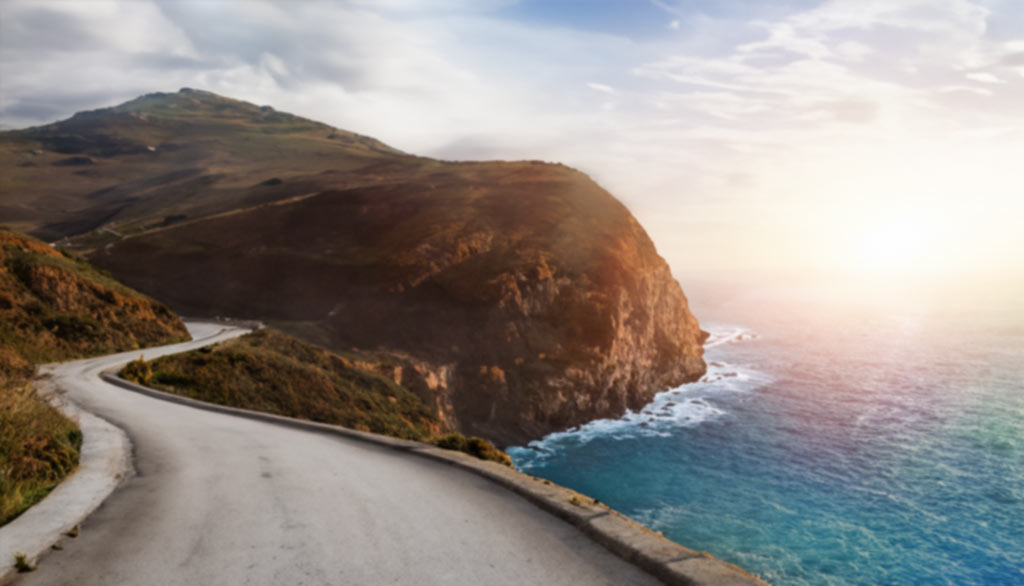The picturesque coastal town of Paleochora occupies a peninsula on Crete’s southwest shore, its strategic location drawing settlers since ancient times. Neolithic, Minoan and Roman era inhabitants all occupied the area, attracted by its coastal resources and defensible position between two bays. During Venetian rule in the 13th century, the fortress of Selino was built to defend Paleochora from pirate raids, remnants of which stand today.
After periods of destruction and revival, Paleochora re-emerged in the 20th century primarily as a fishing village before growing into a relaxed tourist destination renowned for its sandy beaches, laid back ambiance and old town architecture. Visitors can best explore its surroundings and secluded coves by renting a car. Local agencies like Rental Center Crete offer vehicles suited for narrow roads, with the sporty Fiat 500c Cabriolet allowing open-air driving to enjoy the scenery.
Prime beach options include Pachia Ammos, with facilities and golden sands perfect for relaxation. Pebbly Chalikia Beach is tucked among verdant hills for added privacy. A short hike leads to pristine Grammeno Beach, providing unspoiled natural beauty. The adults-only Libyan Princess Hotel occupies a cliff with contemporary rooms boasting panoramic views. Haris Apartments offer tidy studios just 50 metres (0.03 miles) from the beach. The conveniently located Oriental Bay Hotel right on Chalikia Beach tempts with a seaside pool. Highly rated restaurants like Galaxy, MasaSoura and Caravella provide diverse cuisine from traditional Greek to international fusion. Nearby attractions include the sandy Gialiskari Beach, the historic Evangelistra Church and the fascinating Museum of European Warriors. With activities like boating, diving and hiking, Paleochora offers an authentic Cretan experience.
Its turbulent history is visible in remnants of Venetian walls and fortresses. After being destroyed in the 17th century Cretan revolt against Ottoman rule, Paleochora was revived but burned down again during Nazi occupation in World War II. Many inhabitants joined the resistance movement around that time. The town was eventually rebuilt as a fishing village before embracing tourism.
Today Paleochora balances its historic charm, strategic location and access to Crete’s pristine Sfakia region with its popularity as a relaxed resort town known for unspoiled beaches, quaint architecture and gateway access to adventures like hiking, boating and exploring enchanting offshore islets. The availability of car rentals and variety of accommodation options make Paleochora an alluring base for exploring Crete’s scenic southwest coast.
What is the history of Paleochora?
Paleochora was not actually a town in ancient Greek history, which is why it does not have any ancient historical significance. The peninsula on which it is now located was once completely submerged in the ocean. Its highest point — where the remnants of the Venetian fort formerly stood — jutted upward like a little island. The peninsula of Paleochora rose from the sea’s depths as a result of an earthquake. However, in ancient Greek times, the region was home to a city named Kalamyde, which was situated just to the north of where Paleochora is now. Not much is known about this ancient city, but it was presumably the port city for Kandanos, which thrived throughout the Doric and Roman eras, along with the nearby cities of Tara, Lissos, Poikilassos and Syia. The Venetians erected Castel Selino in Paleochora in 1278 because it was a key location for administering southwest Crete and its sea routes. The entire region, which was previously known as Orina, was then renamed after the fort and is today referred to as Selino. Numerous revolts against the Venetians took place throughout Selino and Southwest Crete’s history. Later, in 1653, the Turks took control of Castel Selino and used it for their own gains. The village was later abandoned when the Turks were later compelled to evacuate the fortress. When the British traveller Robert Pashley arrived in the region in 1834, he only discovered the remains of the city. However, a place with so many benefits throughout the course of history could not stay deserted for very long. People began returning to their homes and starting new lives there in 1886. This also explains the origin of its name, Paleochora, which derives its meaning from two different words. Palio, which means old and chora, which means a place or a city. This means that the town’s foundation is an old city’s ruins. This rich, complex history can still be glimpsed in the fortified ruins and charming architecture of modern Paleochora.
Where is Paleochora located?
Paleochora is a charming small town situated in the regional unit of Chania, Greece. It is located approximately 70 km (about 44 miles) south of Chania, on the picturesque southwest coast of Crete. The town occupies a small peninsula with dimensions of 400 metres wide and 700 metres long, offering beautiful views of the surrounding coastline.
Nestled along 11 km (around 6.8 miles) of coastline, Paleochora enjoys its scenic location, bordered by the sparkling waters of the Libyan Sea. This coastal setting makes it a popular destination for visitors seeking relaxation and exploration of the South Cretan Sea. The coordinates for Paleochora are: 35.2295° N latitude and 23.6819° E longitude.
How does Paleochora look on the map?
Below is an image of Paleochora map.

How many people live in Paleochora?
Paleochora has population of 2260 inhabitants, that is X percent of the total population in Greece.The male population is 1109 people, while the female population is 1150. The youth population of Paleochora is: 81 babies, 94 little kids (5 to 9 years old), 108 kids from 10 to 14 years old and 117 teenagers (14 to 19 years old) .
What to you need to know before going to Paleochora?
Before travelling to Paleochora, it’s essential to be well-prepared for a smooth and enjoyable experience. Researching and planning ahead will help ensure you have a worry-free trip. Paleochora’s weather varies throughout the year, so consider the season you’ll be visiting. Summers are perfect for beach enthusiasts, so pack breathable and light clothing along with your swimsuit to make the most of the coastal beauty. The climate in Paleochora is characterised by a Mediterranean charm, with warm and dry summers and mild, wet winters. The average temperatures range from 17°C (63°F) in the spring to 29°C (84°F) in the summer, making it an ideal destination for beach lovers and outdoor enthusiasts. While flip-flops are handy for beach days, travellers should bring comfortable sneakers, as they may be doing a fair amount of walking, including hikes. Visitors should be ready to explore the different Cretan cuisines as there are numerous places to dine whether one is looking for a place by the beach or in the middle of the town centre.
What are the facts about Paleochora?
Listed below are some facts about Paleochora.
- Historical Significance: Paleochora, known as Kalamidi in ancient times, played a vital role in regional maritime trade, leaving behind remnants of ancient civilizations, such as Minoan settlements and Roman structures.
- Venetian Fortress: The Venetian fortress perched on a hilltop offers panoramic views of the city and the sea, dating back to the 13th century when Venetian influence dominated the island.
- Paleochora has amazing nearby beaches: Paleochora is known for its unspoiled beaches, Pachia Ammos and Chalikia, boasting crystal-clear waters and soft golden sands making this one of the many facts about Paleochora.
What are the hiking routes for Paleochora?
Listed below are some of the hiking routes for Paleochora:
- Paleochora Castle and Beach: Paleochora Castle and Beach is a 4.3-km (2.7 miles) out-and-back trail. It is an easy route that takes an average of 51 minutes to complete, making it a perfect choice for hikers seeking a quick yet rewarding adventure. The trail is well-loved by both locals and tourists and remains open year-round, offering the chance to experience its natural beauty anytime. The journey begins with a visit to the Castle of Paleochora, also known as Selino Castle, founded by the Venetians in 1282 AD. This historical fortress stands as a testament to the area’s rich past, having witnessed multiple occupations by the Turks throughout history. The trail continues, leading hikers to the nearby beach, providing an opportunity to enjoy the stunning coastal views and the inviting waters of the Mediterranean Sea. The circular walk around the settlement allows visitors to immerse themselves in the charm of Paleochora while retracing their steps back to the starting point.
- Azogires-Anydri Gorge-Paleochora: Azogires-Anydri Gorge-Paleochora 16.4 km (10.2 miles) trail offers a moderate level of challenge and taking an average of 5 hours and 12 minutes to complete. The route is perfect for hikers seeking a mix of natural beauty, historical landmarks and tranquil moments. Starting from the charming and green settlement of Azogires, northeast of Paleochora, the trail leads southward. Along the way, hikers will encounter the Holy Fathers’ Spring and the “99 Holy Fathers” Monastery, dating back to 1864, adding historical significance to the journey. The path continues at a higher altitude, following a small gorge and finally reaches the village of Anydri. From Anydri, the course descends along the Anydri Gorge towards the sea. As hikers arrive at the beach, they can relish the coastal views before proceeding to the Estuary of the Azogiriano stream and the Keratides Beach. The return journey follows an uphill path through Pappoura hill, leading back to Anydri and then back to Azogires. This year-round open trail promises a serene and beautiful experience, providing an opportunity to immerse oneself in the unique nature and history of Crete. Make sure to carry sufficient water and wear sturdy shoes, especially during the uphill and downhill stretches. The combination of breathtaking landscapes and cultural landmarks makes the Azogires to Anydri Trail a must-visit destination for hiking enthusiasts exploring the wonders of Crete.
- Paleochora-Sougia-Chora Sfakion-Frangokastello: Paleochora-Sougia-Chora Sfakion-Frangokastello is a 69.8-km (43.4 miles) point-to-point trail near Paleochora, Crete, extending along the southern coast. Widely considered a challenging route, it takes an average of 22 hours and 18 minutes to complete. This trail is a favourite among backpackers, campers and hikers due to its scenic beauty. However, even during quieter times of the day, one can still relish moments of solitude. The trail welcomes dogs but requires them to be on a leash. The journey showcases the beauty of the White Mountains’ southern slopes, revealing historical sites and monuments while offering breathtaking views of the region’s imposing gorges and the mesmerising sea. The trail is accessible year-round, making it a year-round gem for explorers and nature enthusiasts and one of the top hiking routes in Paleochora.
Is Paleochora safe?
Yes, Paleochora is definitely a safe destination for tourists. With very low crime rates and a welcoming community, travellers can explore the city and its surroundings with peace of mind, immersing themselves in the local culture and genuine Greek hospitality. Visitors should however be cautious when driving and ensure they park their cars in secure parking areas.
What is the best time for visiting Paleochora?
The best time for visiting Paleochora largely depends on each individual’s preferences and interests. If you’re a beach enthusiast, the ideal time to visit is during the summer, from June to August, when warm temperatures and ideal conditions for swimming and water sports abound. For those who prefer milder weather and outdoor activities, spring (March to May) and autumn (September to November) are great seasons to explore the area. If you seek a quieter and more authentic experience, consider visiting in winter (December to February), the off-peak season, characterised by cooler temperatures and fewer tourists. However, for the ultimate beach experience and lively evenings, the months from May through October are recommended, with sea temperatures consistently above 20°C, peaking in August, making it perfect for swimming and enjoying the coastal beauty.
Do you need to book in advance to visit Paleochora?
No, one doesn’t need to book in advance to visit Paleochora. The city offers a variety of accommodation options, including hotels, guesthouses and vacation rentals. While spontaneous travellers may find availability during the off-peak seasons, it is advisable to book accommodation and car rentals ahead of time during the peak tourist months to secure preferred options. Additionally, booking in advance can help ensure one gets the best rates and have a stress-free travel experience.
What is the best vehicle for visiting Paleochora?
The best vehicle for exploring Paleochora is undoubtedly the Fiat 500c Cabriolet. When visiting this charming coastal town with its picturesque landscapes and enchanting beaches, driving a convertible car like the Fiat 500c Cabriolet will add a touch of excitement and fun to your journey. Its cute and retro look perfectly complements the relaxed and laid-back ambiance of Paleochora.
Beyond its charming appearance, the Fiat 500c Cabriolet is equipped with modern features like automatic climate control, an auto-dimming rearview mirror and heated front seats, ensuring a comfortable and enjoyable driving experience. This allows travellers to fully immerse themselves in the beauty of the surroundings without worrying about the weather conditions. For convenient and affordable Crete car rental, consider getting a company that has no hidden fees.
Can you rent a car going to Paleochora?
Yes, renting a car is a popular and convenient option for travelling to Paleochora. Whether you arrive at Chania International Airport (CHQ) or Heraklion International Airport (HER), car rental services are readily available to cater to your transportation needs. Many car rental agencies offer pick-up and drop-off options at the airports or specific locations within the city.
What factors to consider before renting a car in Crete?
Listed below are the factors to consider before renting a car in Crete.
- Insurance Coverage: Prioritise reviewing the car rental’s insurance policy to guarantee sufficient coverage for accidents and damages. In Crete, rental agencies typically offer insurance options like Collision Damage Waiver.
- Driver’s Age: Be sure to verify the minimum age requirements for renting a car in Crete, as some agencies may have specific age restrictions. Generally, the legal driving age in Crete is 18 years old and a valid driving licence is mandatory.
- Car Type: Select a car type that suits your travel needs and preferences. Whether you plan to explore city streets or embark on off-road adventures, Crete’s rental agencies offer a variety of options. For navigating the narrower Greek roads, opting for a smaller car can be advantageous. This is one of the most overlooked factors by tourists wondering how to choose the right car to rent in Crete.
- Necessary Documents: Make certain you have all the required documents before heading to the rental agency. A valid driver’s licence is essential and you’ll also need to present a credit or debit card in your name for the rental process.
How much does a car rental in Crete cost?
Crete, a stunning island with numerous tourist spots, can be best explored using a rented vehicle. The cost of Crete car rental at Rental Center Crete varies based on factors such as the number of passengers, itinerary, car type, location and rental duration. On average, you can expect to pay around €30 to €40 per day for a rental car in Crete. For a full week’s rental, the average cost is approximately €250, while renting a vehicle for the weekend will cost around €78. Car rentals in Crete offer a diverse selection of cars tailored to customers’ preferences.
What is the nearest airport to pickup / dropoff a car rental in Paleochora?
The nearest location to pickup or dropoff a rental car in Paleochora is the town itself. Since the town is small, there are not many local car hire companies in the area. It is advised to book and collect your car rental in the nearest airport, which is Chania airport. Hiring a car in in Chania airport has the following benefits. Firstly, it is always cheaper to collect car rentals in airports. It is more convenient for car rentals companies, thus they offer more competitive prices. Secondly, visitors save transportation cost to their destination town. In this case, taxi or bus transfer to Paleochora cost € 123 per car per route. Considering the roundtrip cost, it would be much cheaper to hire a rental car. Lastly, easier and quicker pickup. Most Chania airport car rental have offices either inside Chania airport or in very close proximity. The pickup and dropoff processes are more settled and organized which makes the whole experience easier.
What are the best things to do in Paleochora?
Listed below are best things to do in Paleochora.
- Gialiskari Beach: Gialiskari Beach is a beautiful attraction located just 4.5 kms (approximately 2.7 miles) away from Paleochora. This sandy beach offers visitors a serene escape with its clear waters and scenic surroundings, making it a perfect spot for relaxation and sunbathing.
- Evangelistra Church: Evangelistra Church is another notable attraction in close proximity to Paleochora, situated less than a kilometre (approximately 0.5 miles) from the town centre. This historic church holds cultural significance and showcases impressive architecture, making it a worthwhile visit for those interested in local heritage.
- The Acritans of Europe Museum: The Acritans of Europe Museum is on the list of attractions & things to do in Paleochora and is found less than a kilometre (about 0.5 miles) away from the city. This unique museum highlights the history of the Acritans, the mountain warriors of Europe, providing visitors with insights into their traditional way of life and historical background.
What are the best restaurants in Paleochora?
Listed below are some of the best restaurants in Paleochora.
- Galaxy Restaurant: Galaxy Restaurant is conveniently situated in close proximity 450 m (0.24 miles) to Paleochora Centre, offering visitors a diverse menu and a warm and inviting atmosphere. This restaurant is an excellent choice for those seeking a combination of delicious food and pleasant surroundings.
- Caravella Restaurant: Caravella Restaurant is a charming eatery situated 300 m (0.2 miles) from Paleochora centre, where diners can relish a delightful meal while enjoying the coastal views. This makes it the best restaurant to eat and drink in Paleochora as it offers a relaxing ambiance, making it an ideal place to unwind after a day of exploring the city.
- MasaSoura. MasaSoura is perfect for a dinner out with friends, MasaSoura offers a wide range of delicious dishes and beverages that’ll make your tastebuds go crazy. Some of the food you can expect to find here are fish seasoned with lemon, pasta and even lamb chops.
What are the best beaches near Paleochora?
Listed below are the best beaches near Paleochora.
- Gialiskari beach. Gialiskari beach is a pristine pebble beach occupying both sides of a tiny peninsula. It is located about 3 km east of Paleochora, at the end of a dirt road that passes Keratides beach. It’s about a 10-15 minute drive east of Paleochora. It’s considered one of the best beaches near Paleochora because of its dramatic reveal as you drive between two outcrops of rock. It has crystal clear water on both sides of the peninsula and the pebble beach provides some privacy for naturists on one side. The spectacular mountain scenery and views also make it a special beach. There is a small café on the beach, along with some sunbeds and umbrellas. More amenities are available around the corner at Anidri beach. Reviewers describe it as a “hidden gem” with “pristine beauty” and “crystal clear waters”. Some mention the scenic drive to get there being almost as impressive as the beach itself. Gialiskari beach is one of the most popular beaches in the Paleochora area and a popular day trip destination from the town.
- Pachia Ammos Beach. Pachia Ammos is the main town beach on the west side of Paleochora. It is a long, sandy beach spanning about 1 km. It is located right in Paleochora town, running along the entire west side of the village. It is extremely easy to access by foot from anywhere in town. It is considered famous beach in Paleochora because of its soft sand, beautiful views of the coastal hills and prime location for watching sunsets. It is also has Blue Flag beach, meaning it meets high standards for water quality and facilities. As a Blue Flag beach, it is very well-equipped with beach bars, restaurants, umbrellas, sunbeds, showers and toilet facilities. Reviewers describe it as long, sandy and beautiful, with one calling it “one of the best beaches in Chania province”. Some mention Pachia Ammos Beach can get windy. Being right in the heart of Paleochora village, it is the most centrally located and easiest to access of Paleochora’s beaches.

- Chalikia Beach. Chalikia, also known as Pebble Beach, is a picturesque rocky beach on the eastern side of the Paleochora peninsula. It lies right in Paleochora, just past the ferry harbor on the east side of town. Chalikia Beach is located right in Paleochora, just a couple minutes walk from the center of town. It has very clear, clean waters and incredible views across the coastline to the Lefka Ori mountains and Gialiskari Beach. Its proximity to restaurants is also a plus. There are umbrellas, sunbeds and several tavernas located right near the beach. Reviewers mention the “amazing views”, crystalline waters and convenience of having restaurants so close. It’s considered good for avoiding winds that affect the main beach. Its location right in Paleochora makes it a quick and easy beach option. Locals and tourists frequent Chalikia thanks to its beauty and convenience.
- Grammeno Beach. Grammeno Beach is a beautiful sandy and pebble beach located on the Grammeno peninsula just west of Paleochora. It is situated around 4 km west of Paleochora, at the end of the main coastal road leading out of town. Grammeno Beach is only a short 5-10 minute drive west of Paleochora. Grammeno is considered one of the nicest and most family-friendly beaches in Paleochora area, because of its soft sand and sheltered location. As a Blue Flag beach, Grammeno has parking facilities, lifeguards in summer, sunbeds and umbrellas for rent, showers, food kiosks and a campground nearby. Reviewers mention the soft sand, calm waters perfect for kids and overall idyllic setting. Its proximity to Paleochora makes it one of the most popular and frequently visited beaches in town.
- Krios Beach. Krios is a long, pebbly beach located around 9 km west of Paleochora. It is situated west of Paleochora near the village of Koundoura. The beach marks the end of the coastal road leading out from Paleochora. Krios Beach is around a 15-20 minute drive west of Paleochora. It has gorgeous turquoise waters, beautiful coastal scenery with cliffs and a small church and a remote, peaceful atmosphere that attracts those looking to escape the crowds. Krios beach has a taverna, sunbeds, umbrellas and toilet facilities. The eastern end is more organized while the western end is unspoiled. Reviewers call Krios “beautiful”, “serene”, “stunning”, and “one of the most impressive in the region.” They also mention the crystal blue waters and peaceful, secluded atmosphere. Krios beach it an easy day trip beach destination from Paleochora and the beginning of the coastal E4 hiking path.

- Elafonisi Beach. Elafonissi is a stunning beach on its own tiny peninsula/island, known for its white sand and alluring turquoise waters. It is situated on the Elafonissi peninsula in far southwest Crete, around 1 hour 15 minutes drive from Paleochora. Elafonissi is renowned as one of the most beautiful beaches in Greece. The sand in Elafonisi beach, has light pink hues, that is why it is also called, the pink beach. As for amenities, Elafonissi has sunbeds, umbrellas, snack bars, changing rooms, showers and lifeguards in summer. It is a protected nature reserve. Elafonissi beach is a very popular day trip from Paleochora. In summer, boats run daily from Paleochora to Elafonissi.

What are the best hotels to stay in Paleochora?
Listed below are the best hotels to stay in Paleochora.
- Libyan Princess Hotel: Libyan Princess Hotel is a stylish, adults-only hotel located on a hilltop in Paleochora that offers beautiful panoramic views from its outdoor pool and modern rooms with balcony. Just 500 m (0.3 miles) from the centre, Libyan Princess provides comfortable, contemporary accommodations starting at € 100 per night including breakfast. Guests praise the helpful staff and quiet, relaxing atmosphere.
- Haris Studios: Haris Studios offer an excellent value just 50 metres from Paleochora’s pebble beach. Haris Studios provide simple apartments starting from € 50 per night with kitchenettes and private balconies overlooking the Libyan Sea. Its central location near cafes and restaurants is ideal for explorers. Guests compliment the studios’ cleanliness, ocean views and gracious hosts.
- Oriental Bay Hotel: Oriental Bay Hotel is set along Chalikia Beach in Paleochora. Conveniently located, the hotel features bright, modern rooms with balcony from € 90 per night including breakfast. This hotel is ideal for people looking for luxury. Amenities like the seaside pool and bar plus proximity to town attractions make Oriental Bay a comfortable mid-range option. Visitors recommend booking sea view rooms and praise the warm, friendly service.
All these three are some of the best hotels in Paleochora for anybody wanting to visit the beautiful city.
How is the nightlife in Paleochora?
Paleochora has a lively nightlife scene, especially during summer because it is peak season. The town offers a variety of bars, clubs and lounges clustered around the main port and along the coastal roads. A common way to spend evenings in Paleochora is bar-hopping among the many establishments while enjoying drinks and meeting fellow travellers and locals.
What are the best bars in Paleochora?
Listed below are the best bars in Paleochora.
- Monica’s Garden Wine Bar: Monica’s Garden Wine Bar is tucked away in a tranquil courtyard garden which charms guests with its cosy bohemian vibe and superb wine list featuring local Cretan varieties. Guests relax amidst vines and flowers while sipping wines by the glass or bottle, along with cheese and charcuterie boards. Knowledgeable hosts Monica and Stelios elevate the experience with their warm hospitality and expertise.An idyllic spot for wine lovers to unwind.
- Nostos Club & Cocktail Bar: Nostos Club & Cocktail Bar is located along the harborfront. Lively Nostos combines colourful, innovative cocktails, pulsating music and an energetic ambiance perfect for a night out. Guests dance the evening away while master mixologists whip up unique elixirs with premium spirits. Weekly events, themed parties and a beautiful open-air setting overlooking the sea add to the excitement. Nostos is a top spot for experiencing Agios Nikolaos nightlife.
- Agios Bar: Agios Bar, lined up with classic rock music, wood-lined interiors and an extensive selection of rare single malt Scotch whiskeys define this cosy, nautically-themed bar. Located in a neoclassical building near the lake, Agios Bar offers an escape from busy clubs. Pull up to the long wooden bar for serious whiskey tastings and convivial conversations under antique maritime décor. Agios is an iconic, laid-back whiskey lover’s paradise.
Why is Paleochora considered an archaeological site?
Paleochora is known for its historical significance and natural beauty. It is a charming coastal town located in the southwestern part of Crete, Greece and has a rich history dating back to ancient times. Paleochora holds significant archaeological importance due to its historical remnants and ancient ruins, which offer insights into its vibrant past. The city’s ancient name, Kalamidi and its role in regional maritime trade contribute to its archaeological significance. The presence of Minoan settlements and Roman structures adds to the city’s allure as a treasure trove of historical relics. Archaeologists and history enthusiasts can explore and study these remnants, unravelling the secrets of Paleochora’s bygone era.
What are the Archaeological sites near Paleochora?
There are 3 main archaeological sites near Paleochora. These are Kapsa Monastery, Lissos Archeological Site and Archaeological Site of Irtakina. These sites provide a glimpse into the island’s rich history and diverse cultures, from the Eastern Orthodox Kapsa Monastery, to the ancient city of Lissos, to the Hellenistic ruins of Irtakina.
Listed below are the most significant Archaeological sites near Paleochora.
- Lissos Archeological Site. On the southern shore of Chania Prefecture, between Paleochora (west) and Sougia (east), are the remnants of the ancient city of Lissos. The Dorian city of Elyros had a harbour called Lissos near the present-day village of Rodovani. Both Elyros and its two harbours, Sougia and Lissos, were destroyed by the Saracen Arabs, who came in great numbers from Spain. Elyros prospered during the Hellenistic, Roman and First Byzantine eras. Ancient people travelled from all across Crete to Lissos’ famed Temple of Asklepios (Aesculapium) to be healed by the area’s waters. A huge earthquake destroyed the temple. However, the mosaic floor’s animal and geometric pattern images were not lost. You can see the Temple of Asklepios in the morning, but don’t stop there. As you continue your journey through the Lissos Valley, you will also come across column capitals tucked away in the undergrowth and the Roman cemetery’s chamber tombs.
- Archaeological Site of Irtakina. The ancient city of Irtakina, located near Selinos close to the town of Temenia, was constructed at the height of 900 metres above sea level. It was a stand-alone city that experienced tremendous Hellenistic prosperity. Later on, it began to deteriorate throughout the Roman Empire. The remains of a double fortress that once encompassed the city may still be seen in Irtakina. You can also see the remnants of the structures that were a part of the old city in the ruins of this double fortress. An outdoor shrine to the deity Pan was also discovered at the excavation site. The temple was built between the Hellenistic and first centuries BC. Demetra was also worshipped in Irtakina and the temple of Hera is mentioned in an inscription.
- Kapsa Monastery. On Crete’s southeast coast sits the Eastern Orthodox monastery known as Kapsa Monastery. It is situated on a steep, rocky mountain top that overlooks the Libyan Sea and is close to the Perivolakia Gorge’s exit. The Kapsa Monastery was most likely founded in the fourteenth century, while its precise foundation date is unknown. Ottoman pirates invaded the monastery in 1471 and largely destroyed it. Joseph Gerakiontis, a well-known monk who spent his latter years in a nearby cave, renovated it in 1841. The monastery also provided sanctuary to Greek partisans and Allied forces during the Axis occupation of Crete.

Is Paleochora in UNESCO World Heritage Sites?
No, Paleochora is not included in the list of UNESCO World Heritage Sites. While it holds cultural and historical significance, it has not been designated as a World Heritage Site. However, its significance contributes to the overall appeal of Crete as a culturally rich and diverse destination. Two prominent UNESCO World Heritage Sites in Crete are the Palace of Knossos and the Archaeological Site of Phaistos. However, Paleochora does not hold UNESCO World Heritage Site status, it remains a popular destination for its beautiful beaches, relaxed atmosphere and proximity to other historical and natural attractions in the region.
Last updated on .








